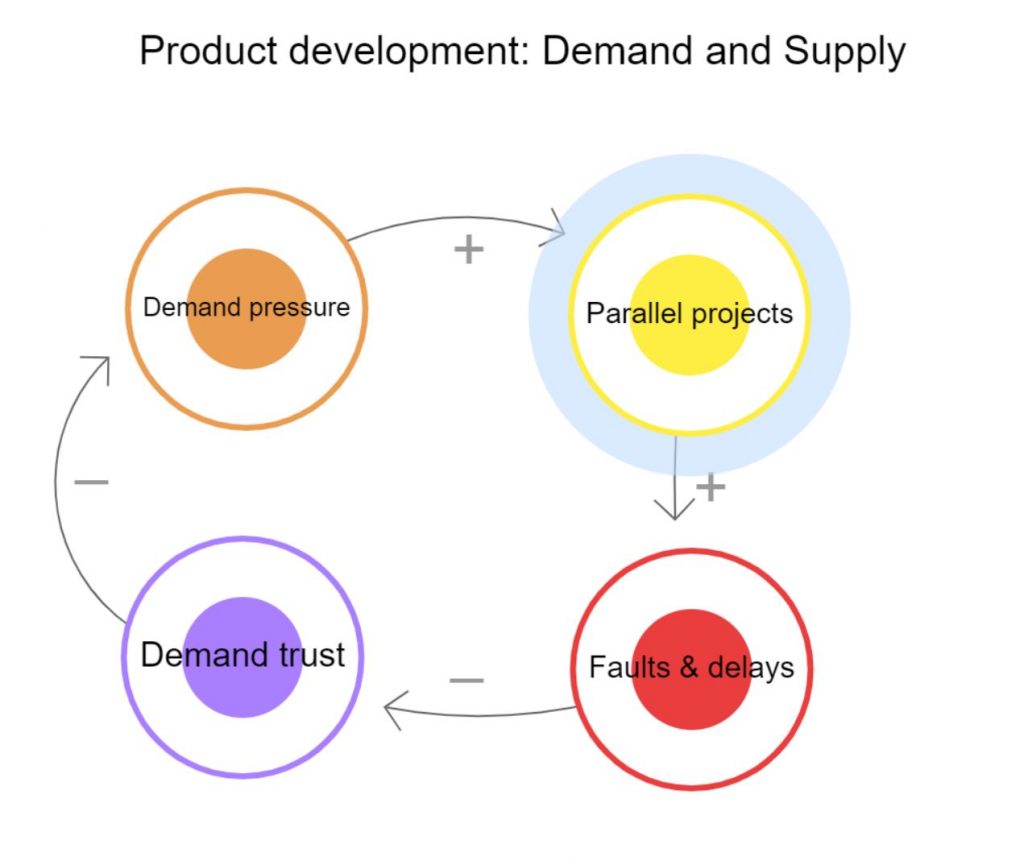“The prevailing management system has destroyed our people” wrote W. Edwards Deming 1990 in the preface of Peter M. Senge’s book “The fifth discipline”, that I’m currently reading again. He explicitly referred to the fact that both managers and employees lose through the prevailing management systems, as his famous saying also expresses: “A bad system will beat a good person every time”.
Deming also says where this problem comes from: “We will never transform the prevailing system of management without transforming the prvailing system of education. […] By the time all children are 10 they know what it takes to get ahead in school and please the teacher – a lesson they carry forward through their career of pleasing the bosses. […] It will take generations, not years, to change such deep embedded beliefs and behaviors.” So it’s also about how we learn in our society, not just how we work.
Peter M. Senge explains in his book on the “Learning Organization” that Systems Thinking is the crucial element to achieve a common awareness. I will go into that more deeply later. I am both thrilled that he had already clearly formulated so many insights into “Learning Organizations” and their prerequisites in 1990, and sad and disappointed that these findings are still so little put into practice. On the other hand, we are now one generation further. Maybe no is the time.
The biggest obstacle to the emergence of a Learning Organization in today’s predominant management systems is the strong incentive to achieve short-term and local success, while disabling important, long-term and organizational changes. This is descibed by the Management Paradox: “Too far away or too powerless”. Within an overloaded system, managers usually don’t even have the time to think about these cause-effect relationships.
Senge assumes a three-tiered behavioral pyramid:
- Reactive: We plan and react to events (event-driven). This is the working mode, which occurs almost automatically when too many things happen simultaneously
- Responsive: We recognize patterns and behave accordingly, but do not recognize the larger relationships
- Generative: We understand the systemic structure and system dynamics and behave accordingly
Systems Thinking
Systems Thinking is the toolbox that makes it possible to model and understand systemic structures and their relationships, and to adapt our behavior accordingly and goal-oriented. The problem is that people can’t even grasp simple relationships of complex systems with delayed reaction times, especially if they can only observe part of the system.
The so-called “Beer Game“, which was developed at MIT in 1960 and has since been tried by generations of management students, shows impressively what happens when local decision-makers have only limited transparency about the overall situation.
In doing so, players, in different roles of a retail chain (retailer, wholesaler, manufacturer), buy beer of a particular brand for which demand has just risen, but without enough stock. Due to the lack of overview, the gamers order more and more beer in each round, which is delivered but only after two rounds. The delays lead to strong “overshoot” of the system, so that in most cases after a few rounds, the beer production is massively inflated.
Insights from the game:
- Lack of global transparency leads to shortsighted local actions, with global adverse effects
- Time delays between action and the visibility of the global effects massively amplify the problem
With Systems Thinking not only economic relationships can be explained, but all kinds of complex systems, e.g..:
- With the formation of traffic congestion,
- global warming,
- the global pollution with plastic garbage.
I’m sure you can imagine some more.
A simple system model of product development
In the model described here, there is a demand organization that has the responsibility for the product business and uses the profits to fund product development in the supply organization. It is relatively natural that the demand organization wants more and more. This forces the supply organization to start more product development projects. At the same time running projects lead to more waiting times (due to congestion in the supply organization) and more mistakes, which in turn leads to a loss of confidence in the demand organization. Loss of trust inevitably leads to even more pressure. It is a doom-loop.
[Click picture to follow the link to the dynamic model, press PLAY and then the ^ arrow in “Demand pressure”, and then come back to this page]
The way out
The way out leads through the following steps:
- the common insight e.g. through system thinking
- Acceptance of the situation, so no blaming
- Creating transparency, what the supply organization can do. This requires trust and openness
- Agreeing on clear priorities (by demand) and focusing on these priorities (by supply): This is easiest to achieve through a Lean/Agile pull system
Start the above model again and press the arrow at “Demand pressure” downwards. You will see that an upward spiral is possible as well.
[Photo by nikko macaspac on Unsplash]

